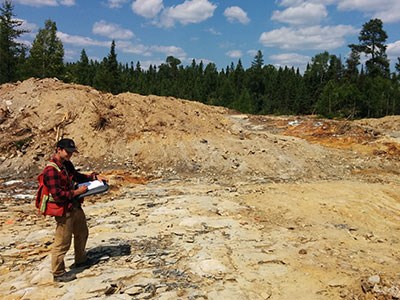Sudbury’s Wallbridge Mining Company started the next phase of exploration on its Parkin Properties in October, with funding from Lonmin.
Wallbridge and Lonmin announced their agreement for the project in mid-September. Lonmin will be funding the project up to $11 million, with the potential to earn up to 50 per cent interest. This was an amendment to their existing North Range Joint Venture agreement (NRJV).
Lonmin is currently Wallbridge’s largest shareholder. The start date of Oct. 1 coincides with the beginning of Lonmin’s fiscal year.
Wallbridge initially worked with Impala Platinum Holdings Limited on the Parkin Properties. Josh Bailey, vice-president of exploration, said that in December, Wallbridge opted to purchase Implats’ 49.6 per cent interest in the joint venture by making cash payments over the next five years.
This shift allowed them to pursue the project with Lonmin, which will cover cash payments to Implats, including retroactively to June 2015 when the first payment was made.
The Parkin Properties are located on the northeast side of the Sudbury basin, on top of the historical Milnet Mine.
Traditionally known for its nickel production, Sudbury mining companies like Wallbridge have turned their focus to platinum rich deposits in recent years.
“They are incredibly high-value deposits,” said Bailey. These deposits draw the interest of shareholders like Implats and Lonmin, which are the second and third largest platinum producers in the world, respectively.
Preliminary drilling and electrical surveys indicate the presence of high-grade polymetallic nickel, copper, and platinum group metals (PGMs) over the properties’ 9.5-kilometre strike length. Detailed geological modelling indicates potential for expansion of the near-surface resource to 1.5 to 5 million tonnes, assuming typical Sudbury grades.
Funding from Lonmin, as a larger partner with more resources, is crucial to this exploration phase of the Parkin properties.
Junior miners have faced significant setbacks over the past few years. Exploration is the riskiest phase, and raising capital for exploration projects is a major challenge.
Wallbridge recognizes the uncertainty of exploring these deposits, writing, “the target is not necessarily indicative of mineralization on the property and there has been insufficient work on the property to determine whether deposits of this size exist.”
But when they attract funding for the exploration through channels like the Lonmin agreement, it “de-risks” the exploration phase.
“While it’s risky, the upside is large,” said Bailey. “This is an option for them to earn in, and let’s them ease into it.”
The agreement with Lonmin is also a major step for Wallbridge’s expansion plans.
The junior mining company, established in 1996, is looking to grow into a mid-tier company and has multiple, advanced production projects on the horizon they’d like to focus on more.
“We’re at a point where we’re in a transition,” said Bailey. “We want to maintain active exploration, but do it by attracting funding from larger partners.”
Wallbridge already has one producing mine. Broken Hammer has been producing copper and PGMs since April 2014. Projects like Broken Hammer contribute to sustainable revenue for Wallbridge, enabling both further exploration and the pursuit of value-accretive near-term production opportunities.
“The main thrust of what we’re doing right now is to mine the Broken Hammer deposit, and realize that revenue.”




